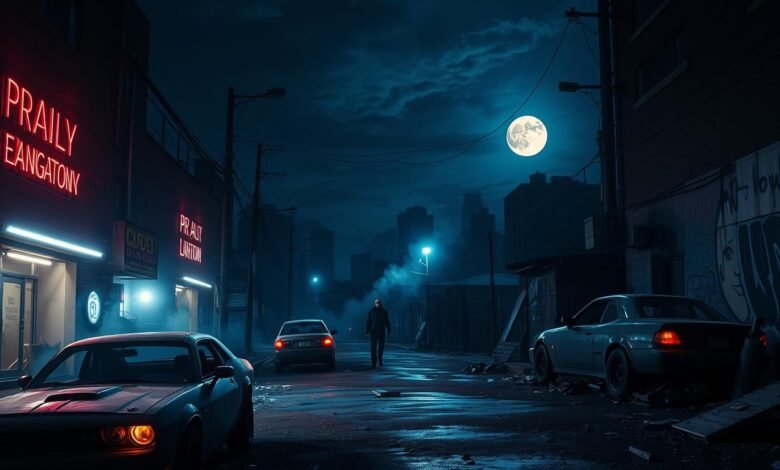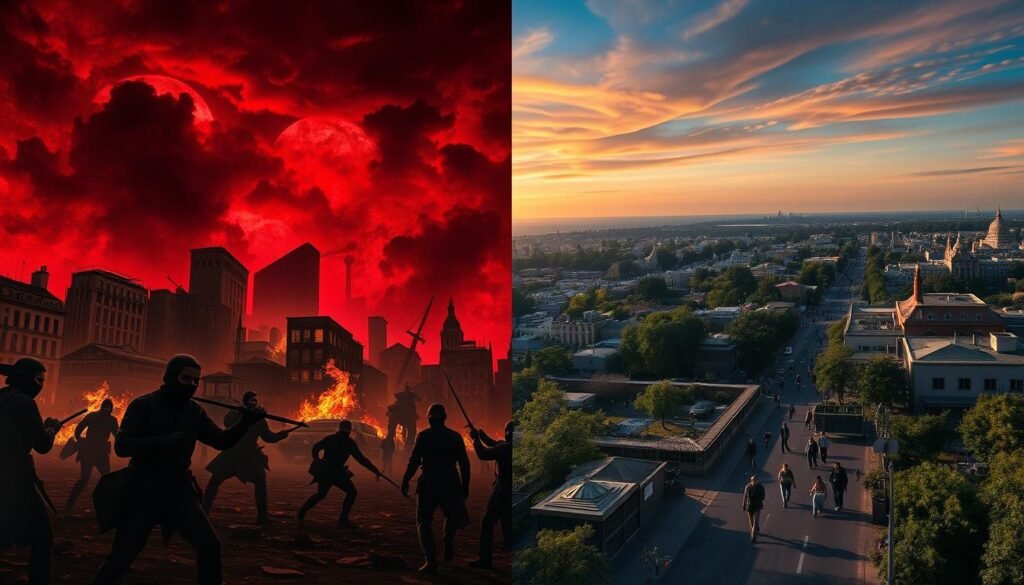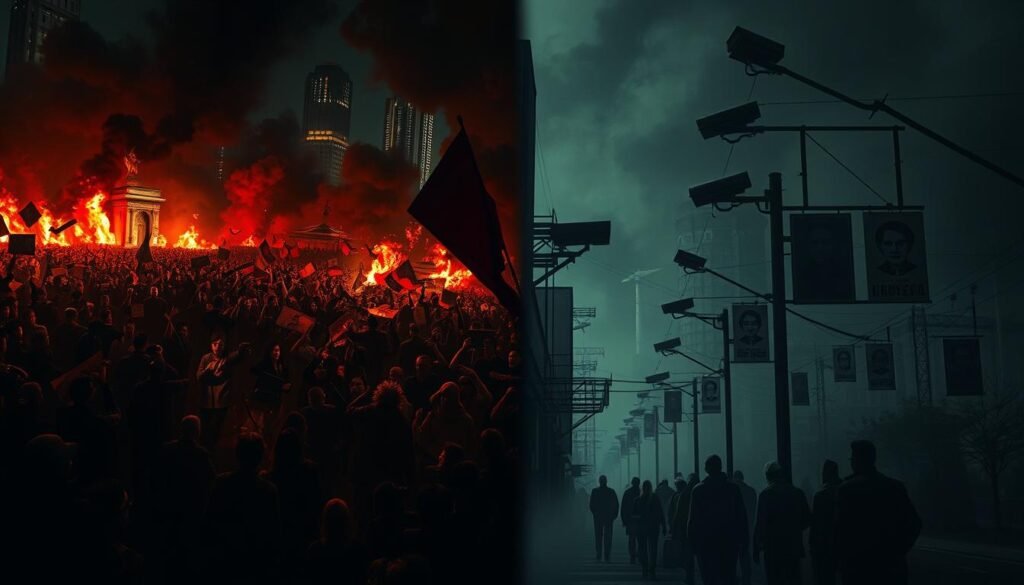Is The Purge Real? Separating Fact from Fiction

The Purge is a gripping dystopian horror franchise that’s captivated audiences worldwide. It imagines a 12-hour period where all crimes are legal in America. This fictional scenario raises questions about its real-world possibility.
This article explores the feasibility and potential consequences of a real-life purge. We’ll examine the driving factors, rules, and economic justifications behind such an event. We’ll also look at the social commentary the franchise provides.
By analyzing fact and fiction, we can grasp the implications of this dystopian concept. We’ll also see its relevance to current societal issues.
Key Takeaways
- The Purge movie franchise has gained widespread popularity, with multiple films and a TV series.
- The premise of the Purge, where all crimes are legal for a 12-hour period, raises questions about its feasibility in the real world.
- The movies and TV series explore themes of social stratification, class divide, and systemic injustice.
- The Purge franchise has been praised for its social commentary, drawing parallels to real-world issues like inequality and oppression.
- Understanding the contrast between the fictional Purge and the realities of human society is essential in separating fact from fiction.
The Premise of The Purge
The Purge series presents a chilling future America. For 12 hours each year, all crimes become legal. The government claims this event fights crime and boosts the economy.
Citizens can release their anger during this time. However, the true purpose is far more disturbing. The wealthy use it to eliminate the poor and marginalized.
Understanding the Dystopian Premise
The Purge explores unchecked violence and eroding ethics. It shows how society can break down when moral boundaries disappear. The films highlight the consequences of abandoning basic human decency.
The Purge: A Night of Lawlessness
During the Purge, people commit crimes without fear of punishment. Some seek personal gain, others revenge. Many simply enjoy the thrill of unbridled violence.
This lawless night reveals how fragile social order can be. It shows the potential for chaos when rules no longer apply.
| Film | Release Year | Production Budget | Worldwide Gross |
|---|---|---|---|
| The Purge | 2013 | $3 million | $89.3 million |
| The Purge: Anarchy | 2014 | $9 million | $111.9 million |
| The Purge: Election Year | 2016 | $10 million | $118 million |
| The First Purge | 2018 | $13 million | $137 million |
| The Forever Purge | 2021 | $18 million | $77 million |
“The Purge films have grossed over $500 million overall, with a combined production budget of $53 million, showcasing the franchise’s remarkable cost-efficiency and growing popularity.”
Overpopulation: A Driving Force
Rapid population growth strains natural resources. The world’s population jumped from 6.1 billion in 2000 to 7.6 billion in 2018. By 2050, it could reach 10 billion. This growth puts pressure on our planet’s resources.
A population purge might seem like a drastic solution. Some may view it as a way to control numbers and manage resources. However, this idea raises serious ethical concerns.
Population Growth and Resource Scarcity
Global population growth is raising alarms about resource sustainability. The U.S. has been at war for 93% of its history. Wars have significant economic impacts.
A purge could be seen as an economic tool. It might address flaws in capitalism. The wealthy could benefit at the expense of the poor.
Governments worldwide are tackling population growth and resource scarcity. They use various planning policies to manage population rates.
- Increasing or decreasing the overall population growth rate
- Managing the relative population growth of specific subgroups
- Ensuring similar average population growth rates across various population groups
Ancient Rome had laws encouraging early marriage and childbirth. They also limited those who didn’t comply. Thomas Malthus influenced 20th-century population planning.
Experts like Sir David Attenborough stress the need to control population growth. They link it to environmental issues and resource depletion. A real-life purge remains highly controversial.
Rules and Limitations of a Real Purge
A real-life purge would have many constraints, unlike the “no rules” scenario in “The Purge” movies. Natural laws and human decency would prevent total lawlessness. Such an event is highly unlikely in reality.
Natural Laws and Human Decency
Crimes against children would likely be forbidden during a purge. Protecting kids is a basic human instinct that goes beyond any temporary law suspension.
The purge rules and limitations would be shaped by natural laws and basic human decency, not just the whims of a dystopian government.
National Security and Whistleblowing
The government would probably set restrictions to address national security issues. They’d aim to stop the release of sensitive info and use of mass destruction weapons.
The purge national security concerns would likely result in rules to suppress whistleblowing and maintain control over critical information.
In reality, a purge would be more complex than shown in films. It would be limited by natural laws, decency, and security concerns.
“The Purge franchise explores the concept of a legalized genocide against the homeless and portrays a dystopian nightmare where crime is legal for a specific period.”
The Economics of a Purge
The “Purge” film series shows a scary 12-hour period where all crime is legal. This idea may seem far-fetched. But looking at its possible economic effects reveals a grim reality.
The government might see the purge as a way to fight overpopulation. It could also be viewed as a method to handle capitalism’s flaws. The poor would suffer most due to lack of defense resources.
Economic benefits, like lower social welfare costs, could drive the purge’s implementation. War is often seen as an economic chance. The purge might be viewed similarly.
The data shows a grim picture of potential economics of purge. It highlights the twisted financial incentives that could arise. The film series serves as a warning tale.
It’s vital to understand the complex link between purge as economic method and its effects. The social and economic consequences could be devastating.
Political Justifications and Congress
The Purge concept transforms the political landscape into a fierce battleground. The government needs to justify this drastic scenario to the public. They must sway public opinion and gain congressional approval.
Various factors would be used to push through this controversial idea. The government would face significant challenges in implementing such a radical policy.
Marxist Capitalism and Inequality
The government might argue that the Purge is needed to fight overpopulation and crime. They could claim it addresses economic issues plaguing the nation. Surprisingly, they might use Marxist principles to justify eliminating poor and marginalized populations.
This approach could frame the Purge as a solution to capitalist inequality. It might appeal to those who feel let down by the current system.
The government could present the Purge as a way to fix capitalism’s flaws. They might argue it would reduce the burden on social welfare programs.
| Justification | Argument |
|---|---|
| Overpopulation | The Purge will reduce the overall population, alleviating resource scarcity and societal pressures. |
| Crime Reduction | By allowing a one-night free-for-all, the Purge will supposedly lower the crime rate for the rest of the year. |
| Economic Inequality | The Purge will eliminate the poor and marginalized, reducing the burden on social welfare programs and promoting Marxist ideals of equality. |
The push for a real-life Purge would face strong opposition from many groups. Civil rights advocates and human rights organizations would likely fight against it.
Many would question the moral and ethical implications of such a drastic measure. The debate would be intense and divisive.
is the purge real
Rumors about a “Purge” event have spread on social media after Illinois eliminated cash bail. The Purge, from a movie franchise, shows a world where crime is legal for 12 hours. However, this is purely fictional and not based in reality.
The Illinois Pretrial Fairness Act aims to reform pretrial procedures, not legalize crime. It’s the first state to fully abolish cash bail. The goal is to remove wealth-based disparities in pretrial detention.
There’s no reliable information supporting a real Purge in 2024 or any year. These claims circulate on social media without credible evidence. This leads to increased fear and anxiety among people.
Promoting a Purge can have serious legal consequences. It could be seen as inciting a riot or making terroristic threats. These actions can result in imprisonment, fines, and civil liability.
Belief in a Purge may be influenced by fear, anxiety, and confirmation bias. Media sensationalism and cultural influences also play a role. It’s crucial to separate fact from fiction.
Separating Fact from Fiction
The Purge movies show a dystopian world that fascinates many. It taps into ideas of lawlessness and potential violence in society. However, there’s no evidence that it will ever become real.
The Illinois Safe-T Act aims to reform the criminal justice system. It’s not creating a Purge scenario. The reforms address wealth-based disparities and promote a fairer system.
Purge movies offer social commentary but are ultimately fiction. Real-world challenges need thoughtful, evidence-based solutions. They don’t require the fictional lawlessness seen in these movies.

Oppression and Marginalization
The Purge franchise offers a stark view of oppression purge and marginalization purge in America. Unlike Orwell’s 1984, The Purge shows targeted oppression of the poor and people of color. This reflects real-world power dynamics in American society.
The government secretly hires mercenaries to attack poor minority neighborhoods during Purge night. Wealthy individuals engage in self-righteous violence, manipulating crime statistics. They aim to eliminate “surplus” population and reduce social safety net costs.
The Relationship Between Power and Marginalization
The Purge shows how power and marginalization work in society. Authoritarianism and state violence thrive on inequality. The ruling party targets the poor and people of color.
This uneven oppression mirrors real-world experiences of marginalized communities in the U.S. It’s a crucial part of the film’s social commentary.
| Statistic | Value |
|---|---|
| Critical approval rating of “The First Purge” film on Rotten Tomatoes | 45% |
| Number of films in The Purge franchise | 4 |
| Spike in sales of Orwell’s novel 1984 after Donald Trump’s inauguration | Significant increase |
The Purge’s uneven oppression purge and marginalization purge highlight real-world inequalities. It shows systemic oppression faced by marginalized communities in the U.S. The franchise offers a powerful look at power, privilege, and marginalization in America.
Comparison to 1984
The purge vs 1984 debate highlights key differences between these dystopian stories. Orwell’s 1984 shows a regime oppressing everyone equally. The Purge offers nuanced purge social commentary on uneven oppression.
In 1984 totalitarianism, the government crushes all dissent and individuality. The Purge shows oppression targeting specific groups. Poor people and minorities face the worst of the government’s harsh policies.
This uneven oppression mirrors real-world power imbalances in America. By showing these gaps, the franchise offers a compelling critique of current issues. It provides a thought-provoking look at society’s problems.
| Characteristic | 1984 | The Purge |
|---|---|---|
| Oppression | Equally distributed | Unevenly distributed |
| Social Commentary | Totalitarian regimes in general | Specific to contemporary American society |
| Narrative Focus | Absolute government control | Socioeconomic and racial disparities |
Both stories serve as warnings about potential futures. However, The Purge explores oppression’s complexities more deeply. This approach makes it more relevant for today’s audiences.

The Purge as Social Commentary
The “Purge” franchise captivates audiences with its thrilling premise and powerful social commentary. These films critique contemporary societal issues, exploring inequality, racism, and privilege. They offer a thought-provoking look at our world’s problems.
Unlike “1984,” which shows equal oppression, the “Purge” movies highlight uneven distribution. Marginalized groups face the worst of the government’s oppressive policies. This aspect makes the franchise’s commentary more relevant to today’s sociopolitical landscape.
The “Purge” premise involves a dystopian society where all crime is legal annually. These movies confront power dynamics between different groups. They raise questions about societal structures and reflect political themes similar to John Carpenter’s films.
Violence and power are central themes in the “Purge” movies. They reveal underlying societal issues within the legalized crime period. The franchise explores class, race, and gender dynamics in a fictionalized lawless society.
“The Purge” movies prompt discussions on issues like gun control, government intrusion, and societal values, making them a valuable tool for exploring the complexities of contemporary social and political issues.
The “Purge” franchise succeeds despite changing main characters and using semi-recognizable TV actors. This success highlights the power of its social commentary. Production companies like Blumhouse excel at creating thought-provoking, socially relevant narratives.
The “Purge” franchise effectively weaves purge as social critique into a thrilling narrative. It explores purge franchise social issues while maintaining commercial success. This makes it a powerful tool for examining the purge social commentary in modern times.
Conclusion
The Purge movies offer a haunting glimpse into a dystopian world. They serve as a mirror, reflecting our society’s struggles with inequality and power imbalances. This analysis delves into the potential factors behind a real-life purge scenario.
We’ve explored the rules, economic justifications, and social impacts of such an event. The Purge’s critique of modern issues surpasses classic works like 1984. It sheds light on today’s complex sociopolitical landscape.
The franchise’s success speaks volumes about audience preferences. Four films earned $320 million on a $22 million budget. Young viewers connect with its challenging narratives and diverse representation.
The Purge, though fictional, sparks crucial conversations about society’s future. It highlights cinema’s power as a platform for social commentary. This examination offers insights into ongoing dialogues about equality and justice.
FAQ
Is the Purge real or just a fictional concept?
The Purge is a fictional dystopian horror movie franchise. It explores a scenario where all crimes are legal for 12 hours. The movies offer social commentary on inequality and power distribution in American society.
What is the premise of The Purge movies?
The Purge films depict a dystopian United States with an annual 12-hour lawless period. During this time, all crimes, including murder, are legal. The government claims it fights crime and boosts the economy, but their motives are sinister.
Could overpopulation be a driving factor for a real-life Purge?
Overpopulation could be a key factor in considering a real-life Purge. The world’s population growth has strained natural resources. This might push a government to use a Purge for population control and resource management.
What are the potential rules and limitations of a real-life Purge?
A real-world Purge wouldn’t be as simple as “no rules.” People have natural laws and human decency that prevent total lawlessness. The government would likely set restrictions to protect national security and limit mass destruction weapons.
What are the potential economic motivations behind a real-life Purge?
The government might justify a Purge to address overpopulation and resource challenges. It could be seen as a way to handle capitalism’s flaws, disadvantaging the poor. Potential economic benefits, like reduced welfare costs, could drive the push for a Purge.
How would the government justify and push through a real-life Purge?
The government might argue a Purge is needed to fight overpopulation, crime, and economic issues. They could use Marxist principles to justify eliminating poor and marginalized populations. These groups are often seen as victims of capitalist inequality.
How does The Purge franchise provide social commentary compared to classic works like 1984?
The Purge shows oppression affects different groups unevenly, unlike 1984’s equal oppression. It highlights how marginalized groups bear the brunt of oppressive policies. This makes The Purge a relevant critique of the U.S. sociopolitical landscape.





